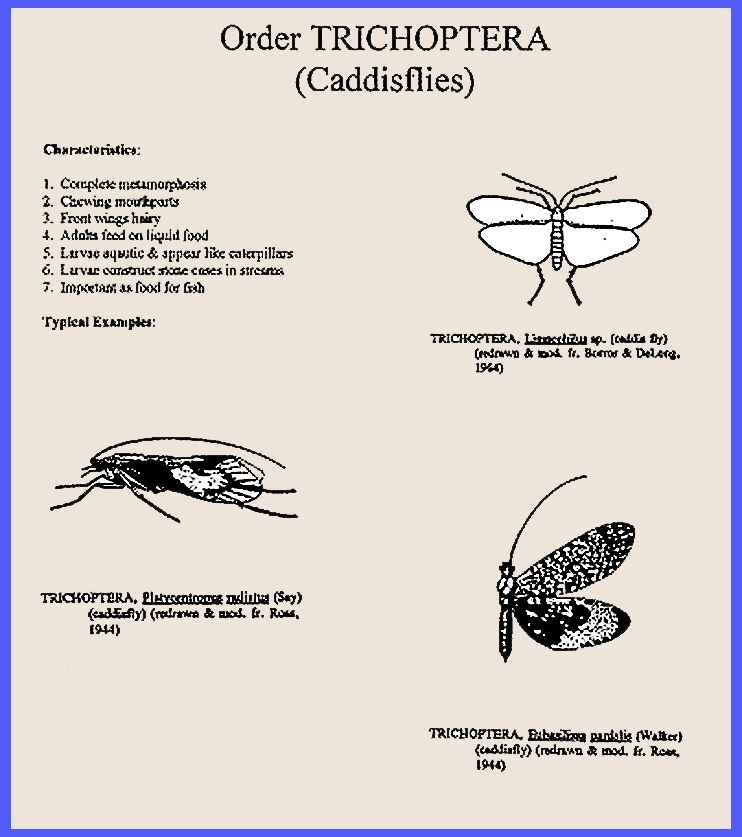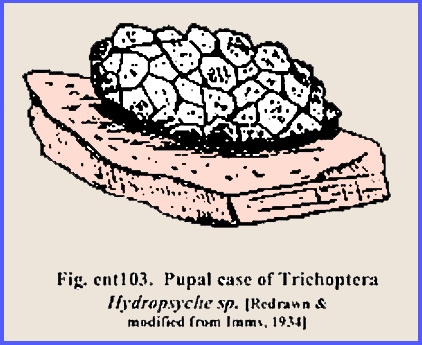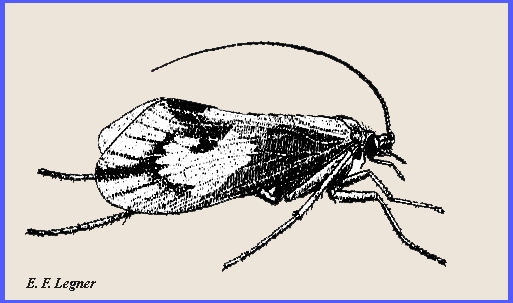File:
<trichoptera.htm> < (Entomology),
(Invertebrates), (General Index)> <Invertebrate
Bibliography> <Glossary> <Site Description> < Home>
|
Entomology: TRICHOPTERA 1 Kingdom: Animalia, Phylum: Arthropoda Subphylum: Hexapoda: Class: Insecta: Order: Trichoptera (Contact)
Please CLICK on underlined
categories to view and on included illustrations to enlarge: Depress Ctrl/F to search for subject matter:
General Summary of
Trichoptera
These drably
colored insects are strong fliers and at sexual maturity may producing mating
swarms. Oviposition may occur directly into the water or the eggs may be laid
on plants above the water where they will await immersion with the winter
floods to hatch. Larvae live in stagnant and
running waters. While most caddisfly
larvae build cases of various materials (sand, small shells and particles of
vegetation) in which they live, e.g. Limnophilus, there are others
that either wander around without a case, e.g. Hydropsyche, or which
move around under stones in running water behind a silken web that they
manufacture to catch small animals carried there in the water, e.g. Plectrocncnemius. The case builders are usually
phytophagous, sluggish and wormlike. The net-spinners are usually carnivorous,
rapid movers and campodeiform. Eruciform
larvae have segmental tufts of tracheal gill filaments on the
abdomen. Campodeiform larvae do not have
these. In whatever degree these two larval types differ from each other they
all possess the diagnostic feature of a pair of abdominal appendages bearing
grappling hooks. Pupation takes place in a silken
cocoon inside the case where this has been used by the larva. Water
circulates through the cocoon making its entrance and exit through the two
ends. The pupa has large mandibles by
which it chews its way out of the cocoon and then by strong swimming actions
of the mesothoracic legs it passes to the shore, there to emerge as an adult
after the final molt. Common examples of case-builders are Phryganea,
Odontocerum and Hydroptila and of net-spinners: Plectrocnemius and
Polycentropus. Rhyacophila and Hydropsyche, common inhabitants
of streams, are wandering carnivores (Borradaile &
Potts, 1958). ------------------------------------------ Trichoptera adults hold their wings
roof-like over the body. Wing
venation is typical but there are no clothing hairs only some very small
hairs are present. The larvae
prepare cases in which they live. The
cases are constructed of river debris such as sand, leaves, wood, etc. The cases are enlarged to accommodate the
growing insect. Water flows through
spaces in the case and may actually be sucked through. The legs of
larvae are for grasping prey. Some
larvae do not make cases but rather spin a net. They have gills on their abdomen. Pupation occurs on rocks that are located under the water. Trichoptera are
valuable food sources for fish and other aquatic animals. ------------------------------------------ Seventeen
families of Trichoptera are distinguished according to their shapes and
habits as follows (see Borror et al. 1989 for details): Beraeidae. -- Small group inhabiting the east
central United States Brachycentridae. -- Immatures feed
on algae near the shores of small streams. Calamoceratidae. -- Adults are
orange or brownish with 5-6 segmented maxillary palps. Goeridae. -- Adult males have 3-segmented and
females 5-segmented maxillary palps Helicopsychidae. -- Snail case
caddisflies. Hydropsychidae. -- Net spinning
caddisflies Hydroptilidae. -- Micro
caddisflies Lepidostomatidae. --Adult males have
1-3 segmented & females 5 segmented maxillary palps. Leptoceridae. -- Long horned
caddisflies Limnephilidae. -- Northern
caddisflies Molannidae. -- Small sandy
stream and lake inhabiting caddisflies Odontoceridae. -- Adults average
13 mm long and inhabit swift streams. Philopotamidae. -- Fingernet
caddisflies Phryganeidae. -- Large
caddisflies Psychomyiidae. -- Tube making and
trumpet net caddisflies Rhyacophilidae. -- Primitive
caddisflies Sericostomatidae. -- Only one genus
occurs in lakes and streams. ------------------------------------------- Details
of Insect Taxonomic Groups Examples of
beneficial species occur in almost every insect order, and considerable
information on morphology and habits has been assembled. Therefore, the principal groups of insect
parasitoids and predators provide details that refer to the entire class
Insecta. These details are available
at <taxnames.htm>. ============== |



